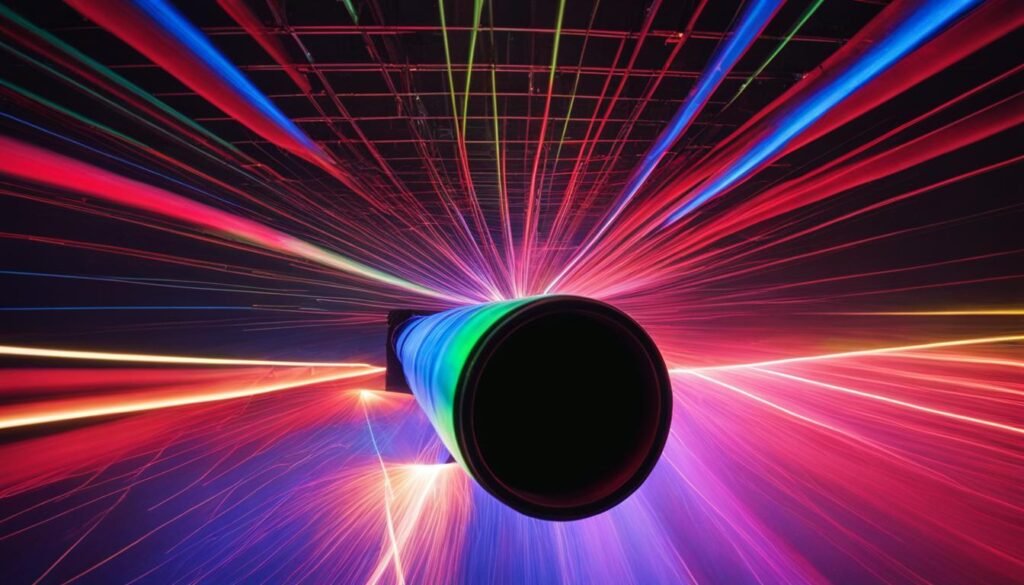Contents
- 1 The Advancements of Vertical External-Cavity Surface-Emitting Lasers (VECSELs)
- 1.1 Introduction to VECSELs
- 1.2 Working Principle
- 1.3 Electrical vs. Optical Pumping
- 1.4 Cooling Techniques and Power Scalability
- 1.5 Materials for Different Emission Wavelengths
- 1.6 Placement of Quantum Wells
- 1.7 Intracavity Frequency Doubling
- 1.8 Ultrashort Pulse Generation with Mode Locking
- 1.9 Future Potential
- 1.10 Conclusion

Source: MDPI
The Advancements of Vertical External-Cavity Surface-Emitting Lasers (VECSELs)
Introduction to VECSELs
A Vertical External-Cavity Surface-Emitting Laser (VECSEL) is a type of semiconductor laser that can produce high optical powers in diffraction-limited beams. Compared to other semiconductor lasers, VECSELs offer advantages in terms of wavelength versatility and beam quality.
Working Principle
VECSELs consist of a semiconductor gain chip with a gain region containing quantum wells, mounted on a heat sink. The laser resonator includes external optical elements, such as mirrors and filters, to complete the setup. By controlling the resonator setup, VECSELs can produce high-quality laser beams.
Electrical vs. Optical Pumping
VECSELs can be electrically or optically pumped. While electrical pumping is simpler, optical pumping allows for uniform pumping of large active areas, enabling higher output powers. Optical pumping is achieved using high-brightness laser diodes or diode bars.
Cooling Techniques and Power Scalability
VECSELs require efficient cooling to handle heat dissipation. Techniques like thin semiconductor structures on heat sinks or transparent heat spreaders can enhance cooling efficiency. These methods enable power scalability by doubling the output power through increased active areas.
Materials for Different Emission Wavelengths
The choice of semiconductor materials in VECSELs depends on the desired emission wavelength. Different material combinations, such as InGaAs or GaInNAs, are used for wavelengths ranging from infrared to visible and even ultraviolet regions.
Placement of Quantum Wells
Quantum wells in VECSEL gain structures are strategically positioned to maximize gain for the lasing wavelength. The number of quantum wells affects gain, but also introduces challenges like inhomogeneous gain saturation and temperature sensitivity.
Intracavity Frequency Doubling
VECSELs with high intracavity power are suitable for intracavity frequency doubling using nonlinear crystals. This enables efficient generation of red, green, and blue laser sources for various applications, such as laser projection displays.
Ultrashort Pulse Generation with Mode Locking
VECSELs support mode-locked operation for ultrashort pulse generation at gigahertz repetition rates. Passive mode locking with semiconductor saturable absorber mirrors has significantly improved pulse generation capabilities in VECSELs.
Future Potential
VECSELs offer a promising future with their wavelength versatility, high output power, and potential for cost-effective mass production. These lasers are expected to replace traditional solid-state lasers in various applications, especially where unique wavelengths or high beam quality are required.
Conclusion
In conclusion, VECSELs represent a significant advancement in semiconductor laser technology, offering a combination of high power, beam quality, and versatility. With ongoing research and development, VECSELs are poised to revolutionize laser applications across different industries.

Source: SFB 1083
Feel free to comment your thoughts.



